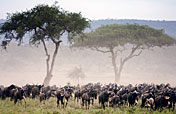Serengeti National Park
- Overview Serengeti Safaris
About Serengeti National Park
 The Serengeti is one of the most famous parks in Africa and is
synonymous with wildlife and classic African scenery. It is Tanzania’s
oldest park and a Unesco World Heritage Site. It is home to the
spectacular wildebeest migration and offers top-class wildlife viewing
throughout the year.
The Serengeti is one of the most famous parks in Africa and is
synonymous with wildlife and classic African scenery. It is Tanzania’s
oldest park and a Unesco World Heritage Site. It is home to the
spectacular wildebeest migration and offers top-class wildlife viewing
throughout the year. - Size: 13,250km²/5,116mi²
- Altitude: 1,139-2,174m/3,737-7,133ft
- Annual wildebeest migration (late January to August)
- Top wildlife viewing all year-round
- Endless plains feel like authentic Africa
- Superb for spotting predators
- Excellent mid-range and luxury lodges
- Hot air balloon safaris
- The Seronera area gets crowded during peak season (June and July and October to April)
The Wildebeest Migration Every year, over 2 million wildebeest, zebra and gazelle migrate from the Serengeti to the Masai Mara Reserve in Kenya. If you're there at the right time, you can spot herds of wild beast and zebra stretching to the horizon.
Wildlife The Serengeti offers some of the best wildlife viewing in Africa. All the major safari animals occur in great numbers. Cheetah and four of the Big 5 are easily seen, but rhino sightings are rare, and only black rhino are present.
More about the wildlife
Scenery Serengeti's scenery is renowned for its grassland plains in the southeast. The northern part is more hilly and rocky. To the west, valleys, rivers and forest can be found. The land is stunning and feels like untamed wilderness.
Weather & Climate Conditions in the Serengeti are rarely taxing in the daytime during the Dry season (June to October), when the temperature stays nice and warm. It’s a different story at night, when the mercury can take a deep dive. The heat creeps up a few degrees during the Wet season (November to May), though the odd cold front can introduce a chill.
More about the weather and climate
Best Time to Visit Overall, wildlife watchers are better off timing their trip to coincide with the drier months (June to October). Aim for June and July if you can, as the incredible wildebeest migration usually tramples the plains at this time. If you’re keen on seeing predators in action, visit in late January or February. This is the hiatus in the annual rains, when the wild beast.
https://www.safaribookings.com/serengeti/photos?photo_id=1

Go straight to the point
ReplyDelete